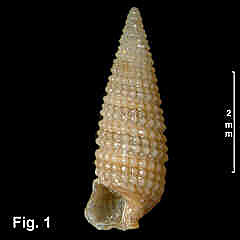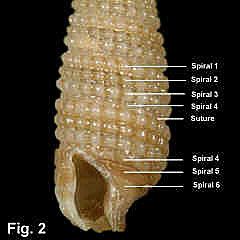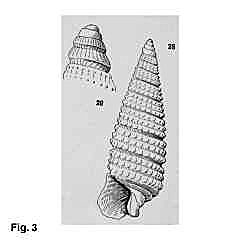|
|
TRIPHORIDAE |
|
|
|
Costatophora granifera (Brazier, 1894) Description: Shell relatively small, sinistral, partly translucent. Protoconch plankotrophic, of 4½-5½ whorls, with a fine spiral thread and numerous axial riblets. Teleoconch weakly convex; adult shells of about 4-9 teleoconch whorls. Teleoconch whorls with 4 beaded spiral cords and axial costae; spirals 1 and 3 commence immediately after protoconch, spiral 2 commences simultaneously or later; spiral 4 just visible on all whorls. Another 2 spiral cords on base (numbered 5 and 6); spiral 5 broad, low, smooth, spiral 6 obsolete. Spirals 1-4 of similar size on all but earliest whorls. Axial costae of similar strength to spirals, strongly nodulose at intersections, 16-24 on penultimate whorl. Outer lip of aperture flared, anterior siphonal canal short and slightly upturned, posterior canal a broad triangular notch. Protoconch colour yellowish brown. Teleoconch colour and pattern very variable; usually shades of yellowish or reddish brown, with nodules lighter. Size: Mature shell 2.1- 7.5 mm in length. Distribution: Endemic to Australia: Iluka, NSW, southwards and around southern Australia to Shark Bay, WA, including Tas. Habitat: Living specimens are locally common in the intertidal zone on rocky shores. Empty shells are know from beach washup and commonly down to 100 m, and rarely down to 549 m. Synonymy: Three species described by Laseron (1954) were synonymised by Marshall (1983): Notosinister pocula was based on a rare colour form; N. topazica and N. jacksonensis were based on exceptionally large specimens, of 6 mm and 5.5 mm respectively. Remarks: This is the most common triphorid in temperate Australia, often found in beach washup. Figs. 1, 2: Clarence River [mouth], NSW (C.116211) Fig. 3: From Hedley, 1903, pl. 33, figs 28, 29 |
|


